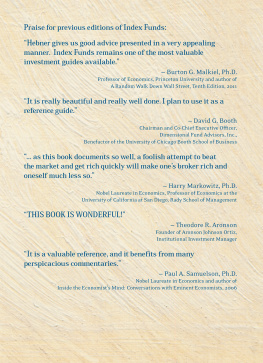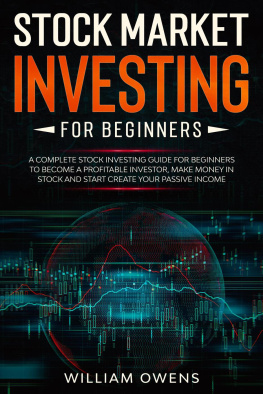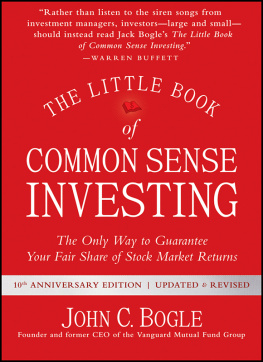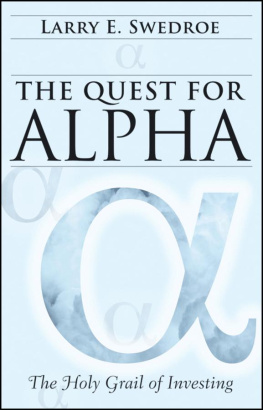INDEX FUNDS

Copyright 2011, 2012, 2013, 2015 by IFA Publishing, Inc.
FOURTH PRINTING
All rights reserved. Except as permitted under the United States Copyright Act of 1976, no part of this publication may be reproduced or distributed in any form or by any means, or stored in a database or retrieval system, without the prior written permission of the publisher.
This publication is designed to provide accurate, authoritative and educational information in regard to the subject matter covered. It is sold with the understanding that the author is engaged in providing professional investment advisory services, but is not rendering legal, accounting or other professional services. If legal, accounting or other expert assistance is required, the services of a competent professional person should be sought.
Representations of individuals and/or institutions are not necessarily an endorsement of any investment philosophy or strategy presented in this book. Please see additional disclaimers in . Printed in China.
ISBN: 978-0-9768023-1-0 (Print)
ISBN: 978-0-9768023-5-8 (eBook)
T his book is dedicated to: Beth, Brie,
Kory, Ian, Tyler, Tessa, and Emma
ACKNOWLEDGEMENTS
I would like to extend my gratitude to the many people who have assisted in the creation of this book. They include: Mary Brunson, Jay Franklin, Jackson Lin, Robert Bray, Kris Cooper, Tom Allen, Michael Auchterlonie, Judy Baba, Cindy Mason, Michelle Ojeda, Max Weinberg, Tyler Collins, Tyler Means, and Harry Markowitz. Many original works of art by Lala Ragimov and Aftab Alam bring color and life to the science of investing.
Thank you also to the many IFA team members, clients and friends who have assisted and encouraged me in my mission to change the way the world invests, by replacing speculation with an education.
TABLE OF CONTENTS
FOREWORD

It will fluctuate.
J.P. Morgans reply when asked what the stock market will do.
In this volume Mark Hebner meticulously refutes the idea that individual investors can beat the market by stock selection or market timing. Some readers may react with the thought that perhaps most investors cannot beat the market, but some can. I merely have to emulate those with superior performance. Examples of investors with sustained superior performance include the legendary Warren Buffett and David Swensen, Yale Universitys Chief Investment Officer, whose performance over decades has been widely admired and imitated by endowment and retirement plan managers, but with rare success.
If you examine the words and practices of these distinguished investors, you will find their above-market performance is not due to a set of rules which can be followed by individual investors. Rather, it is due to resources and opportunities which individual investors and most institutional investors do not have. Mr. Swensen tells how he does it in his book, Pioneering Portfolio Management: An Unconventional Approach to Institutional Investment. As noted in the title, Swensens book
Few, if any, individual investors have the time and skill to separate the gems from the quarry rock, even if they were presented with similar opportunities. Any individual investor who believes he or she can achieve above-market performance is almost sure to underperform the market substantially.
Hardly any institutional investors are able to outperform their proper benchmarks. Among those who do accomplish this feat, their ranks largely change from year to year, making their discovery a moving target, as Mark Hebner shows in this volume. Swensen affirms the difficulty of identifying skilled fund managers. He states, I erred in describing my target audiences. In fact, I have come to believe that the most important distinction does not separate individuals and institutions few institutions and even fewer individuals exhibit the ability and commit the resources to produce risk-adjusted excess returns.
Indeed, the challenge of ferreting out the gems from among the tons of quarry rock is more challenging than it might first appear.
While Warren Buffett has not written a text on the subject, his actions show his success like Swensens is in part due to his being offered opportunities not available to the individual investor. Specifically, he is offered the opportunity to take large positions in established companies at favorable prices. At such times, company information is made available to Mr. Buffett and his staff which is not routinely available to the public. Ultimately, however, it is his and his staffs ability to evaluate such positions to separate the gems from the quarry rock that explains their long-run success. As in the case of Swensens outperformance, few individual investors have the time and skill to evaluate such opportunities, even if they were presented to them.
As to market timing, I know of no one who has consistently outperformed the market by market timing. Since there are always countless authorities who say to buy, and countless others who say to sell, there will always be many instances in which someone called correctly the last turn of the market, and even the last two or three turns. As Hebner documents, it is a foolish hope to try to emulate such market timers. It is better to go with J.P. Morgans advice that all one knows about the market is that it will fluctuate.
J.P. Morgans observation has at least three implications. The obvious one is: Dont try to time the market. You will make your broker rich, not yourself. Another implication is you should choose a portfolio you can live with despite market fluctuations. For example, the year 2008 was not an outlier, nor was it even the worst year on record. Rather it was tied for the second worst year. It was a one-in-forty year event, not a one-in-a-thousand year event. The frightened investor who decided to get out of the market in March of 2009 locked in his or her losses for good. The chief problem with small investors is they buy when the market has gone up and believe it will rise further, and they sell when the market has fallen and believe it will fall more. One of the principal functions of the right financial advisor is to make sure the investor understands the volatility of his or her specific portfolio and is willing to stick with it for the long run.
As Mark Hebner explains, a third implication of the fact that markets fluctuate is the need to rebalance. Suppose an investor is comfortable with a 60-40 mix of stocks versus bonds. If the market rises substantially, the portfolios equity exposure will greatly exceed sixty percent. The rebalancing process sells off the excess, bringing the portfolio back to a 60-40 mix. If the market falls, then the portfolio will have less invested in stocks than the target 60 percent. The rebalancing process then buys. This process of rebalancing which sells when the market is up and buys when the market is down is sometimes referred to as volatility capture and leads to what Fernholz and Shay (1979) refer to as excess growth. The rebalanced portfolio will grow faster than the average growth of its individual constituents. It may even grow faster than any one of its constituents due to the rebalancing process. Thus, if handled knowledgeably, market volatility can be the investors friend.










